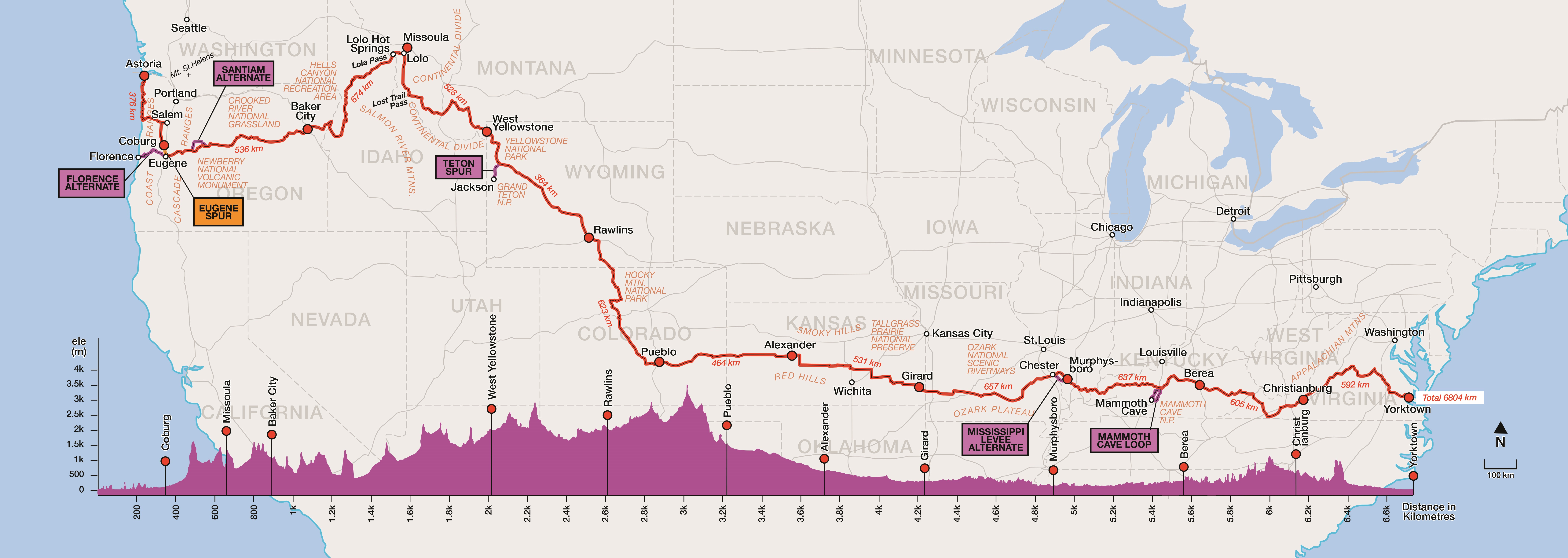Excluding any thought of quitting is the key to completing this epic feat of solo endurance.
Ultra-endurance cycling events are a small, but growing, niche, with examples like the Race Across America, Tour Divide (North America), Freedom Challenge (South Africa) and Transcontinental (Belgium to Istanbul) growing in both attendance and media attention. But if there’s one such event on the radar of Australian readers, it’s probably the Trans Am—a lazy 6,800km across the USA—owing to the publicity that came as a result of local rider Jesse Carlsson’s victory in the race in 2015. Inspired by his success, Melbourne endurance cyclist Sarah Hammond signed up for the 2016 event, and has been hard in training, with Jesse’s guidance, in preparation for departure from Oregon on June 4. Ride On sat down with Jesse and Sarah to find out more about the how, and why, of preparing for an almost unfathomable event like this.
What is the Trans Am?
Jesse: The Trans Am Bike Race is a non-stop, self-supported road race along the 6,800 km Trans America Trail. The course is a popular coast-to-coast bike touring route across the United States, passing through ten states from the Pacific to the Atlantic. It’s a 100% bitumen route, popular with cycle tourists who typically bite off chunks of the route to ride in their annual holidays. In 2014, a few riders, veterans of similar adventures, posed the question, “how fast can we ride it?” and decided to race it for the first time. 2016 will be the third instalment of the race, and at the moment there are around 100 riders from 16 countries on the 2016 roster.
What support is there?
Trans Am racers must carry everything they need to survive—food, water, warm clothes, wet weather gear, sleeping equipment and more. As is the case for most bikepacking events, riders can access commercial services along the way but support crews or team cars are not allowed. Riders have to find their own food and water, fix bike issues out in the wilderness, carry all the equipment and spares they need to be safe, and find places to catch a few hours of sleep along the way.
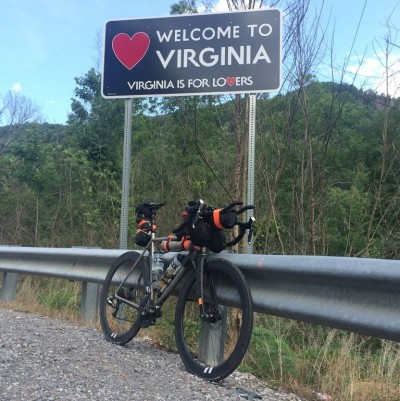
Jesse entering Virginia, Trans Am 2015.
That sounds ridiculously tough. Why would you want to do such a thing?
It’s not for the prize money—there isn’t any. It’s not for the glory—not many people know about the event. So why would you enter? For many people, I think it’s a mix of a few reasons:
You’re looking for adventure: In these events you get a bike touring adventure but with a sense of urgency. You see spectacular high-country vistas, get intimidated by the threat of tornadoes, chat with locals over breakfast in small-town diners, but when you’re ripping along at distances of up to 400km per day you can pack a lot into your annual leave.
You’re a racer looking for something more: These events are as tough as they come. If you’re into racing why not test yourself in the toughest events available? You’re forced to confront your biggest fears and push through the nastiest of dark low points.
Respecting the pioneers: You were probably attracted to these events by the feats of the pioneering riders who have set fast times in the past. You have a respect for them that is hard to explain and think that maybe, just maybe, you could join their elite club!
How did you prepare for this kind of thing?
Part of the preparation is obviously riding. A lot. It’s important to get the body, especially the back, knees and Achilles, used to backing up big days one after another. It’s also important to build a bank of experience that you can fall back on when times get tough during the race and know that you’ll get through.
Just as important though, is building confidence in your kit. You carry a lot of gear in these races to stay safe in a range of conditions. It’s important to head out into the wilderness to make sure your kit works before rolling up to the start line.
I think mental preparation is perhaps the most important aspect. You really need to know why you’re doing the event and make an agreement with yourself up front that you’re going to finish. You need to know what you’re going to do to keep yourself moving when everything is screaming, “QUIT!”
What gives way first – the mental or physical side?
I think the mental side gives away first. You’re never riding at a ridiculous tooth-grinding pace. You just can’t stop. You have to keep moving. With the sleep deprivation and physical load, the mind gets foggy pretty quickly. I’ve spent hours in a mental loop worried about where my credit card was, only to check and find it exactly where it always is. But then I’d worry that I’d imagined that I’d checked where the card was. So I’d have to check again … and again.
All riders have aches and pains along the way. Almost all riders complain of Achilles, knee or back pain. It’s all part of these events. Riders who want to finish manage these issues as well as they can. Those who don’t, use them as an acceptable excuse to quit.
What was the lowpoint of the ride for you?
A bout of gastro through the high mountains in Colorado was tough. I struggled to keep any food down for about three days. Collapsing in a campground toilet and waking up not knowing where I was, how long I’d been there or what I was doing was a bit scary. It’s pretty tough forcing food into a nauseous stomach but you’ve got to try. I had an extended break in Breckenridge to try to clear the illness, which mostly worked but the sickness really affected my pace for the remainder of the race.
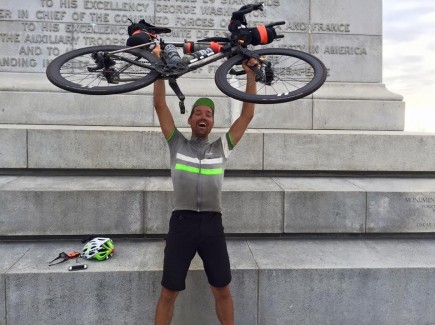
Jesse at the finish of the 2015 Trans Am.
For your ride last year, what was your total time, average distance per day, and average speed?
I finished in 18 days 23 hrs. I had two extended breaks—one due to sickness and one due to tornadoes in the area. Excluding those spells, I averaged just under 400km per day. At the pointy end, riders don’t get a lot of sleep—usually around four hours. Sometimes a little more, and if the racing’s tight, sometimes less. That doesn’t sound like much but it’s amazing what the human body can put up with.
What are the logistical challenges in nutrition and hydration?
Forget traditional race nutrition, the race is too long to carry bars and gels. You’d need a trailer! Riders make do with whatever they can find along the way, often stopping at small-town diners for huge breakfasts or finding fast food to take away. Sometimes things don’t go to plan and the shops are closed when you pass through a town—maybe it’s late, maybe it’s Sunday and everything is closed. In times like that you need to make sure you always have something in reserve to eat, just in case.

A selection of the ride food that Jesse consumed during the Trans Am.
How do you keep motivation up through the ride?
It’s tough. I treat it as a long, slow meditation under duress. The motivation comes before you start the ride. You need to make an agreement with yourself that you’re going to finish well before you start and then along the way remind yourself of that agreement. If thoughts of quitting appear during the race you have to let them go. You can’t latch onto them because before you know it you’ll be running through the long list of reasons to quit, trying to find the one that fits best. You have to let the thought of quitting go. Even if the thought appears a thousand times, your job is to let it go.
What sort of weather conditions would you anticipate?
You have to prepare for the worst and hope for the best in these events. Last year’s event had very hot conditions early on in eastern Oregon, cool weather coming through Yellowstone and then tropical storms over in the east. As I came through a small town in Illinois I had to take shelter as the tornado siren was sounding. You never know what you’re going to face.
What physical ailments did you experience/ would you expect to encounter?
Riders can expect to have issues with Achilles tendons, knees, necks and backs. Achilles tendon and knee overuse injuries are probably the most common reasons for quitting. Aside from that the digestive system is under constant abuse—heartburn and digestive issues are also reasonably common.
Does it kill your love for bike riding?
No. But it does kill your enthusiasm for shorter races. It makes you want to look for the next big adventure. It’s addictive.
Would you do it again or is once enough?
I’d love to if a strong field of riders fronted up but at the moment I’m focussed on other adventures. I’m holding a race in September this year, the Race to the Rock. It’s going to be a 2,300km self-supported race from Adelaide to Uluru, mostly off-road, through some very remote country. Having raced twice across the US, it’s probably time I did some more riding in my own country.
Any advice for Sarah?
My advice to Sarah would be the following. Always. Keep. Moving. While it’s difficult, I hope she doesn’t get overawed by the strong competition. She’s tougher than 99.9% of her competition and when she’s suffering out there in terrible conditions I hope she’ll realise that her opponents are going to be suffering even more than her!
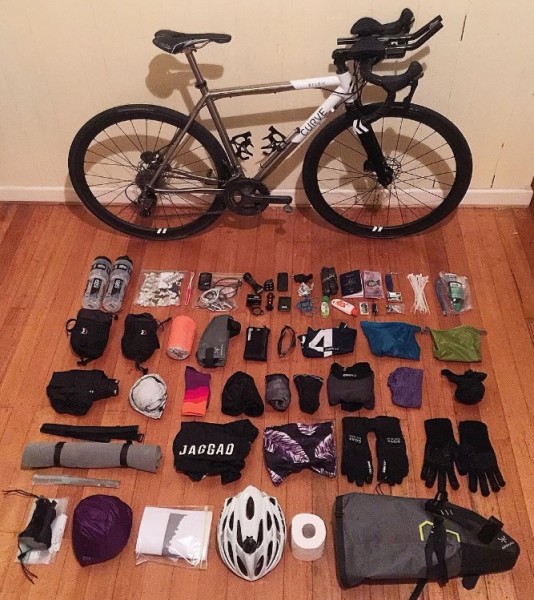
Sarah’s bike and kit setup. Image: Sarah Hammond / Instagram @flexgoogly
And what was your inspiration for this ride, Sarah?
Sarah: A little over a year ago, Jesse posted a map of the US, and asked if anyone was up for a spin. My first thought was he was crazy. However—for those of us that are fortunate enough to know Jesse—we know that there isn’t all that much that this man can’t ride through.
Watching Jesse’s tracker as he rode off on the other contenders across the US, each day creating a larger lead was incredible to watch. Despite food poisoning and injury he kept pushing on, eventually coming in first over the finish line in Yorktown, Virginia.
The thought went through my head about what it would take to do this, and having never been shy of just ‘doing’, I started to entertain the idea of signing up for 2016.
Of course, the moment Jesse got wind of this, it was like a nagging voice that wouldn’t go away until I fully committed.
Had you ridden anything like this before?
No—my longest ride at that point had been 350kms. The Trans Am is a staggering 6,800km, with close to 60,000m of vertical hell. To prepare, I obviously needed to start riding a lot more, and a lot further.
Can you give us an example of what that sort of training looks like?
In a bid to extend my mental toughness and leg endurance, Jesse invited me along to his yearly ride back home to Adelaide. The idea was to complete the ride without sleep, stopping for food only when needed. In total we covered 812km in under 40 hours. The first 600km went quickly and without much effort, but in the darker hours of the morning the sleep monsters took over and rendered me useless for quite a number of hours. My legs became robotic—no problem there—however, my mind closed up and keeping my eyes open was so difficult. I had many moments of needing to stop and just sit and refocus. I was given the first insight into how to manage sleep deprivation and the voices that say “quit, stop, turn back and give up”.
After I’d blurted out a few tears, Jesse asked me if I wanted to finish or not. This has been a massive learning for me with everything I’ve tackled since. You need to make the decision to finish long before you even start. Your head will continue to create reasons to quit but hanging onto the ‘no option’ for giving up is what has successfully pushed me on since.
How has the preparation gone since then?
I’m a big procrastinator, so this past month or two it’s been all last minute sorting of bike bits, map study, elevation profiles, product research and, of course, dialling in my bike set-up out on the road with some overnight ventures.
What challenges do you expect to encounter?
I know the biggest challenge will be my inexperience with bikepacking trips. I have strengths in other areas but the isolation from routine will be the hardest part for me.
I fully expect it will be the most difficult adventure I’ve ever taken on, and no doubt I’ll want to bin the bike on day three, but my targets have been set for what I want to achieve and I plan to stick to them as best I can. My inner monologue will be to just keep moving at all times, and eating. It’s all in the hands of the bike gods now.
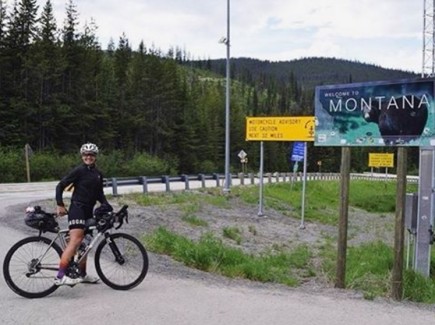
Image: Anthony Dryer & Nathan Jones. Source: Instagram/@flexgoogly
—
After stunning the ultra-endurance cycling scene by leading the race overall for much of the first week, Sarah was sitting in fourth position, having averaged over 400km a day and—following a wrong turn—ridden an extra 120km than the other competitors.
After 18 days, Sarah is just over 500 miles from the finish in Yorktown, Virginia, and looks likely to be the second place female rider.
You can follow Sarah’s progress on transambikerace.com, or the regularly updated Facebook fan-page (with some great insight from Jesse). You can also donate to support her ride on GoFundMe.
Ride On content is editorially independent, but is supported financially by members of Bicycle Network. If you enjoy our articles and want to support the future publication of high-quality content, please consider helping out by becoming a member.

